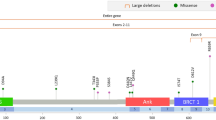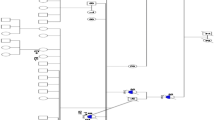Abstract
Inherited mutations in the tumor suppressor genes BRCA1 and BRCA2 predispose carriers to breast and ovarian cancer. The authors have identified a mutation in BRCA2, 7845+1G>A (c.7617+1G>A), not previously regarded as deleterious because of incorrect mapping of the splice junction in the originally published genomic reference sequence. This reference sequence is generally used in many laboratories and it maps the mutation 16 base pairs inside intron 15. However, according to the recent reference sequences the mutation is located in the consensus donor splice sequence. By reverse transcriptase analysis, loss of exon 15 in the final transcript interrupting the open reading frame was demonstrated. Furthermore, the mutation segregates with a cancer phenotype in 18 Danish families. By genetic analysis of more than 3,500 Danish breast/ovarian cancer risk families, the mutation was identified as the most common BRCA2 mutation in West Denmark, while it is rare in Central and East Denmark and not identified in South Sweden. Haplotype analysis using dense SNP arrays indicated a common founder of the mutation approximately 1,500 years ago.



Similar content being viewed by others
Reference List
Collaborativ group (2002) Breast cancer and breastfeeding: collaborative reanalysis of individual data from 47 epidemiological studies in 30 countries, including 50,302 women with breast cancer and 96,973 women without the disease. Lancet 360:187–195
Gerdes AM, Cruger DG, Thomassen M, Kruse TA (2006) Evaluation of two different models to predict BRCA1 and BRCA2 mutations in a cohort of Danish hereditary breast and/or ovarian cancer families. Clin Genet 69:171–178
Thorlacius S, Sigurdsson S, Bjarnadottir H, Olafsdottir G, Jonasson JG, Tryggvadottir L, Tulinius H, Eyfjord JE (1997) Study of a single BRCA2 mutation with high carrier frequency in a small population. Am J Hum Genet 60:1079–1084
Dorum A, Hovig E, Trope C, Inganas M, Moller P (1999) Three per cent of Norwegian ovarian cancers are caused by BRCA1 1675delA or 1135insA. Eur J Cancer 35:779–781. doi:S0959804999000507
Hansen TV, Ejlertsen B, Albrechtsen A, Bergsten E, Bjerregaard P, Hansen T, Myrhoj T, Nielsen PB, Timmermans-Wielenga V, Andersen MK, Jonson L, Nielsen FC (2009) A common Greenlandic Inuit BRCA1 RING domain founder mutation. Breast Cancer Res Treat 115:69–76. doi:10.1007/s10549-008-0060-z
Abeliovich D, Kaduri L, Lerer I, Weinberg N, Amir G, Sagi M, Zlotogora J, Heching N, Peretz T (1997) The founder mutations 185delAG and 5382insC in BRCA1 and 6174delT in BRCA2 appear in 60% of ovarian cancer and 30% of early-onset breast cancer patients among Ashkenazi women. Am J Hum Genet 60:505–514
Thomassen M, Hansen TV, Borg A, Lianee HT, Wikman F, Pedersen IS, Bisgaard ML, Nielsen FC, Kruse TA, Gerdes AM (2008) BRCA1 and BRCA2 mutations in Danish families with hereditary breast and/or ovarian cancer. Acta Oncol 47:772–777. doi:791892967[pii];10.1080/02841860802004974
Cruger DG, Kruse TA, Gerdes AM (2005) ‘Indirect’ BRCA1/2 testing: a useful approach in hereditary breast and ovarian cancer families without a living affected relative. Clin Genet 68:228–233. doi:CGE484[pii];10.1111/j.1399-0004.2005.00484.x
Li Q, Liu Z, Monroe H, Culiat CT (2002) Integrated platform for detection of DNA sequence variants using capillary array electrophoresis. Electrophoresis 23:1499–1511. doi:10.1002/1522-2683(200205)23:10<1499:AID-ELPS1499>3.0.CO;2-X
Hogervorst FB, Cornelis RS, Bout M, Van Vliet M, Oosterwijk JC, Olmer R, Bakker B, Klijn JG, Vasen HF, Meijers-Heijboer H (1995) Rapid detection of BRCA1 mutations by the protein truncation test. Nat Genet 10:208–212. doi:10.1038/ng0695-208
Mohammadi L, Vreeswijk MP, Oldenburg R, Van den Ouweland A, Oosterwijk JC, van der Hout AH, Hoogerbrugge N, Ligtenberg M, Ausems MG, van der Luijt RB, Dommering CJ, Gille JJ, Verhoef S, Hogervorst FB, van Os TA, Gomez GE, Blok MJ, Wijnen JT, Helmer Q, Devilee P, van Asperen CJ, van Houwelingen HC (2009) A simple method for co-segregation analysis to evaluate the pathogenicity of unclassified variants; BRCA1 and BRCA2 as an example. BMC Cancer 9:211. doi:10.1186/1471-2407-9-211
Wooster R, Bignell G, Lancaster J, Swift S, Seal S, Mangion J, Collins N, Gregory S, Gumbs C, Micklem G (1995) Identification of the breast cancer susceptibility gene BRCA2. Nature 378:789–792
Bergthorsson JT, Ejlertsen B, Olsen JH, Borg A, Nielsen KV, Barkardottir RB, Klausen S, Mouridsen HT, Winther K, Fenger K, Niebuhr A, Harboe TL, Niebuhr E (2001) BRCA1 and BRCA2 mutation status and cancer family history of Danish women affected with multifocal or bilateral breast cancer at a young age. J Med Genet 38:361–368
Gutiérrez-Enríquez S, Coderch V, Masas M, Balmaña J, Diez O (2009) The variants BRCA1 IVS6-1G>A and BRCA2 IVS15+1G>A lead to aberrant splicing of the transcripts. Breast Cancer Res Treat 117:461–465. doi:10.1007/s10549-008-0154-7
Borg A, Haile RW, Malone KE, Capanu M, Diep A, Torngren T, Teraoka S, Begg CB, Thomas DC, Concannon P, Mellemkjaer L, Bernstein L, Tellhed L, Xue S, Olson ER, Liang X, Dolle J, Borresen-Dale AL, Bernstein JL (2010) Characterization of BRCA1 and BRCA2 deleterious mutations and variants of unknown clinical significance in unilateral and bilateral breast cancer: the WECARE study. Hum Mutat 31:E1200–E1240. doi:10.1002/humu.21202
Acknowledgments
Susan N Rasmussen, Dorte F Jensen, Jette Thinggaard and Flemming H Bergholdt are thanked for excellent technical assistance. This study was supported by the Neye Foundation.
Conflict of interest
None.
Author information
Authors and Affiliations
Corresponding author
Rights and permissions
About this article
Cite this article
Thomassen, M., Pedersen, I.S., Vogel, I. et al. A BRCA2 mutation incorrectly mapped in the original BRCA2 reference sequence, is a common West Danish founder mutation disrupting mRNA splicing. Breast Cancer Res Treat 128, 179–185 (2011). https://doi.org/10.1007/s10549-010-1272-6
Received:
Accepted:
Published:
Issue Date:
DOI: https://doi.org/10.1007/s10549-010-1272-6




